Bayer R.G. Mechanical Wear Fundamentals and Testing, Revised and Expanded
Подождите немного. Документ загружается.

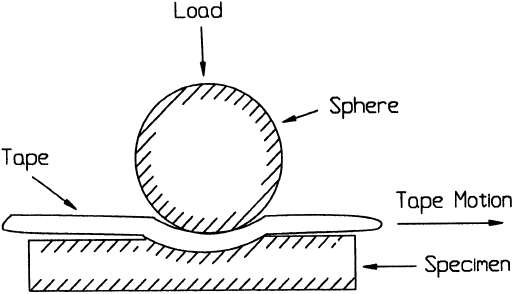
great deal of flexibility in the load, sphere radius, speed, and materials used, as well as
with the conditions surrounding the test (e.g., lubrication, temperature, and humidity).
To a large degree, these parameters can be adjusted to simulate magnetic recording
applications. However, the basic geometry of the co ntact situation and stress system
are significantly different than in typical applications (e.g., those shown in Fig. 9.72).
The method used to rank magnetic tapes in terms of their abrasivity is similar to that
used for printer ribbons, namely, to determine a wear coeffici ent. This wear coefficient
is the volume of wear divided by the product of the normal load, speed, and time of the
test. The higher the value of this coefficient, the more abrasive the tape is.
The controllable parameters and the use of a wear coefficient in this test provide a
more general description of the wear situation and makes the results more suitable to
general models and theories for wear. In the SCAT test, many of these parameters
are indirectly controlled and not specifically identified. This illustrates some of the differ-
ences typically associated with the two categories of tests. In general, the phenomeno lo-
gical test tends to have a potential for greater applicability or generalization than the
operational test.
With appropriate values of parameters, the spherical test can rank tapes of signifi-
cantly different abrasiveness that is consistent with field data. However, the wear rates
in the test are typically several orders of magnitude higher than observed in practice
(e.g., 10
4
times higher). While this is the case, the wear rates from the SCAT test
are typical of those observed in practice. This difference between the two tests is the
result of poor simulation of the contact situation in the spherical test and good simula-
tion in the SCAT test. As this implies, the spherical test provides a high degree of
acceleration and allows tests times to be reduced from hours, required with the SCAT
test, to minutes. At the same time such a difference introduces more concern regarding
correlation with the field and the ability of the test to provide accurate rankings. This
illustrates another typical difference between phenomenological and operational tests.
With an operational test, there is usually less concern with correlation, since the degree
of simulation is high, and a minimal amount of effort is needed to establish correlation.
With a phenomenological test, there is generally more concern in this area and more
effort is required to establish correlation. In this particular case, there is a higher degree
of confidence in the rankings provided by the SCAT test than those provided by the
spherical test, because of the higher degree of simulation in the SCAT test.
Figure 9.74 The configuration of a phenomenological test used for magnetic head applications.
Copyright 2004 by Marcel Dekker, Inc. All Rights Reserved.
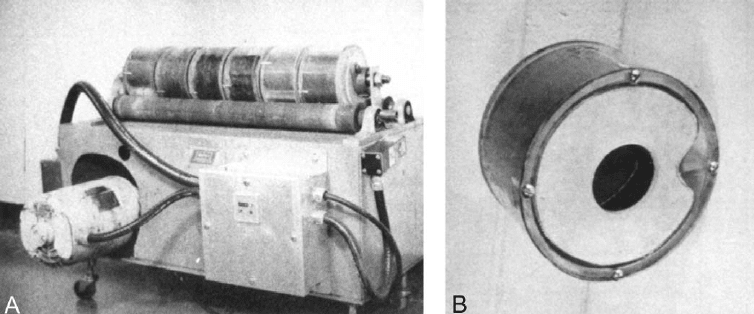
9.3.3. Coin Wear Test
One type of test that has been used to simulate the wear of coins is a tumbling test. Test
coins are placed inside a suitably designed drum and tumbled (80,81). The basic concept
of the test is to simulate the rubbing that coins experience against one another in pockets,
change drawers, etc. This is achieved by placing coins is a plastic drum, which is lined with
a rubber-backed cloth. The interior of the drum has an axial ridge, which provides agita-
tiontothecoinsasthedrumisrotated(Fig.9.75
). To simulate possible chemical effects
associated with hand ling of coins, the co ins can be coated or dipped with artificial per-
spiration. Basically the test method consists of tumbling the coins for a period of time
and determining mass loss. This is done at intervals so that a wear curve can be developed,
which is used to establish an average wear rate (i.e., wear per unit time). In addition
to directly using the mass loss as a measure of wear, thickness reduction is also used
particularly when comparisons of different materials are involved. This is done by divi-
ding the mass loss by the product of density and the nominal surface area of the coin
(including the side area).
This test was investigated and used to evaluate the wear rates of different coin mate-
rials (80). As part of the investigation of this test and its correlation to the field, the influ-
ence of several of the test parameters were investigated to select optimum and desirable
values for these parameters. The goal was to select values which result in producing similar
wear characteristics to that found in the field, to minimize test time, and to reduce scatter
in the data. Included in these were the effects of the number of coins in the drum, cylinder
size, drum rotational speed, and the influence of chemical agents. It was concluded that the
number of coins in the drum, the size of the drum, and total linear distance of rotation
influence the wear. Total linear distance is the product of the inner circumference, revolu-
tions per unit time, and time. It was found that different sizes of coins would wear at dif-
ferent rates, depending on the number of coins tumbled, up to a total of 12 coins after
which the same wear rate was obtained. Thus, 12 coins are used in the standard test.
For a given drum size it was found that the wear curve was linear and that the amount
of wear was simply dependent on total linear distance. However it was found that the wear
rate was higher with smaller diameter drums; hence a smaller drum and higher rpm was
Figure 9.75 ‘‘A’’ shows the overall apparatus used to study coin wear. ‘‘B’’ shows an individual
drum that is used to tumble the coins. (From Ref. 126, reprinted with permission from ASME.)
Copyright 2004 by Marcel Dekker, Inc. All Rights Reserved.

chosen as the standard test. It was also found that the chemical agents and the manner of
their application influence wear behavior, which lead to the well-controlled use of artificial
perspiration as a standard part of the test procedure.
In addition to these sensitivity evaluations during the initial portion of the develop-
ment of the test, the morphology of tested coins was also compared to that of field-worn
coinstoinsurethatitwasrepresentative.AsillustratedinFig.9.76
, the appearance of
tested coins was similar to used coins. In addition since field-worn coins tended to show
increases in hardness with time in use, tested coins were also examined for an increase
in hardness. A similar behavior was found with tested coins, supporting the case for simu-
lation. Furthermore, this increase in hardness suggests that a major factor in the wear is
coin=coin interactions. This is consistent with the results of the sensitivity studies. The
increased wear rate observed with larger number of coins and small drum size indicate
that wear by the drum liner is minor. The standard test conditions selected tend to
enhance this type of interaction.
This is an accelerated test in terms of time or use. Comparison of test wear rates
and field wear rates indicated acceleration factors in the range of 100–1000 times. The
actual value is dependent on the conditions of use (e.g., degree of coin-usage in the
society and the general environmental co nditions associated with that society). For
example, comparison with Canadian coins indicates a value of 600, while a similar com-
parison with El Salvadorian coins indicates a value of 300. A partial reason for this
difference is probably associ ated with the difference in coin-usage in the Canadian
and El Salvadorian societies (i.e., more coin-usage is considered likely in El Salvador).
Also, the environmental conditions of the two countries are significantly different.
Figure 9.76 Examples of coins worn in the tumbling apparatus. (From Ref. 126, reprinted with
permission from ASME.)
Copyright 2004 by Marcel Dekker, Inc. All Rights Reserved.
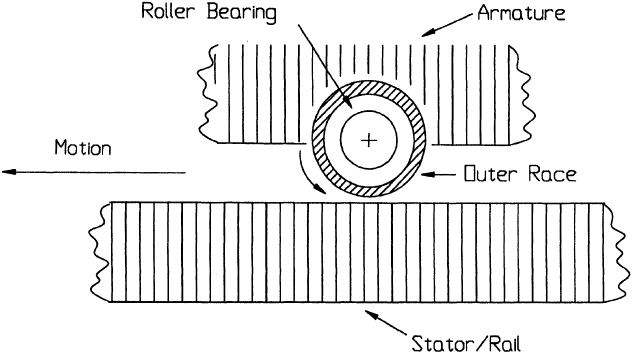
El Salvador has a hotter, more humid, marine-type atmosphere than does Canada.
The laboratory test s indicate that such environmental conditions will tend to increase
wear rate.
While this test does not provide a characterization of wear behavior in terms of more
fundamental parameters, such as load, speed, or sliding distance, it not only provides a
ranking of materials but it also provides a quantitative assessment of field performance
through an acceleration factor. These are frequently features of operational tests. With
these attributes, such tests are very useful for specific applications. On the other hand,
it is difficult to apply the results of such tests to other applications or to general wear
behavior.
9.3.4. Test for Rolling with Misalignment
This test was developed to address problems associated with a linear stepper motor used
inarobot(Fig.9.77
). In this motor, the stator acts as a rail upon which the armature
moves back and forth. Conventional ball bearings are used as wheels for the armature,
with the outer race being the wheel surface, which engage the stator. In this type of
actuator, the wheels serve to support the weight of the armature and any other weight that
is being trans ported and to provide guidance with a minimum of friction . The magnetic
coupling between the stator provides accelerations and deceler ations parallel to the sur-
face of the rail and the armature. Some degree of misalignment between the ball bear-
ings and the surfaces of the stator was likely to be present in most assemblies and
considered to be a significant factor in wear life. To obtain adequate life, there was a
need to select and optimize several design parameters in terms of their influence on wear.
This included the selection of material s and the evaluation of lubricants. In addition, it
was also necessary to select bearing size and the contour of their outer race, evaluate the
effect of load, and determine tolerances needed to control alignment. All of these can
affect wear and are interrelated tribosystem parameters.
The wear situation may be described as rolling wear with some slip. Based on the
general trend, it is expected that the wear rate will increase with the amount of slip
Figure 9.77 Diagram of the rolling contact situation occurring in a linear stepper motor
application.
Copyright 2004 by Marcel Dekker, Inc. All Rights Reserved.
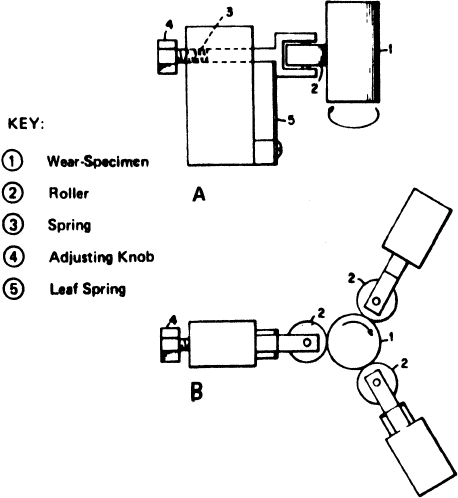
occurring in the contact and that this will be a major factor in overall wear behavior.
There are two potential sources of slip: one is misalignment, with the amount of slip
increasing with the degree of misalignment present and the other is slip during starting
and stopping of the motor. Since the rollers do not provide traction for starting or stop-
ping, the latter source was considered unlikely and actual motor tests with different
ratios of start=stops to total distance traveled confirmed this. Consequently, it was
concluded that it was not necessary to simulate start=stop behavior in a wear test used
to evaluate materials and design parameters.
A test apparatus and technique was developed to investigate the influence of the var-
iousdesignparametersinthiswearsituationandtoselectmaterials(82)(Fig.9.78
). It con-
sisted of a driven central cylindrical wear specimen, which rotates about its axis. This
cylinder simulates the rail or stator. Pressed against the wear specimen are three ball bear-
ings located 120
apart at three different locations along the axis of the wear specimen.
These can be varied and simulate the rollers in the application. The apparatus was de-
signed so that the normal load, rotational speed, and roller alignment could be varied as
well. Hence, the contact situation in this app aratus was very similar to that in the appli-
cation. There were some differences, which were not considered significant. One apparent
difference is that in the test apparatus the contact is between two cylinders, while in the
application it is between a cylinder and a flat. This difference is minor since the general
nature, i.e., a line contact, and stress dist ributions of the contacts are the same according
to Hertz contact theory. Another difference was in terms of the relative wearing action
that the two members experience. The bearing surfaces in the tester experience about
2.5 times more wear acti on than the wear specimen. In the application, the bearings
Figure 9.78 Configuration of the tester used to investigate the wear between the roller and the sta-
tor in a linear stepper motor application. (From Ref. 127, reprinted with permission from ASME.)
Copyright 2004 by Marcel Dekker, Inc. All Rights Reserved.
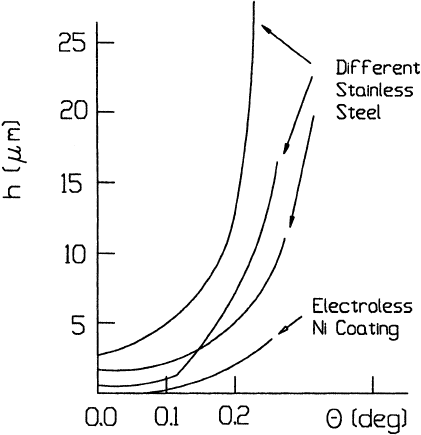
experienced a varying amount, depending on the movement associated with the robotic
action and the ratio can vary from something less than 1 to more than 10, with higher
values being more typical. This was not considered to be significant since the ratio in
the test was in the range of that for the application. The use of this type of wear apparatus
was considered to be more advantageous than motor tests, because it provided adequate
simulation with a greater degree of control of key design parameters of load, alignment,
speed, ball bearing geometry, materials, and lubrication.
The rollers were positioned in the test apparatus such that they did not interfere with
one another. Their wear tracks are separate and, since 120
separate them, wear debris
from one track would not contaminate another. As a result, it is possible to simultaneously
conduct tests at three different alignments at the same time. This has an advantage in that
it facilitates the assessment of misalignment effects as a function of the other design para-
meters. For example, the developers of the test utilized three standard angles for much of
their evaluations, namely 0
, 0.117
and 0.235
of axial misalignment. Examples of some
ofthedifferencesseeninthismannerareshowninFig.9.79
.
The test method consisted of characterizing and measuring the amount of wear as a
function of number of revolutions. This was done for different combinations of design
parameters. For the wear specimen, the maximum depth of the scar was used as a measure
of wear. This was determined by means of profilometer trace s through the wear scar,
which gives a natural reference surface for this type of measurement. Since the outer races
of the ball bearings are usually significantly harder than the surfaces of the rail materials,
little wear is produced on the roller surfaces. However, surface modifications did occur.
These were characterized by optical and SEM micrographs, EDX, and roughness
measurements. Features such as the occurrence of transfer, oxidation, polishing, and
smoothing were noted and used in the overall wear assessment of the system. These tech-
niques were used to examine the wear specimen as well, and similar notations were made.
Figure 9.79 The effect of misalignment on the wear of the center specimen in the rolling test.
(From Ref. 127.)
Copyright 2004 by Marcel Dekker, Inc. All Rights Reserved.
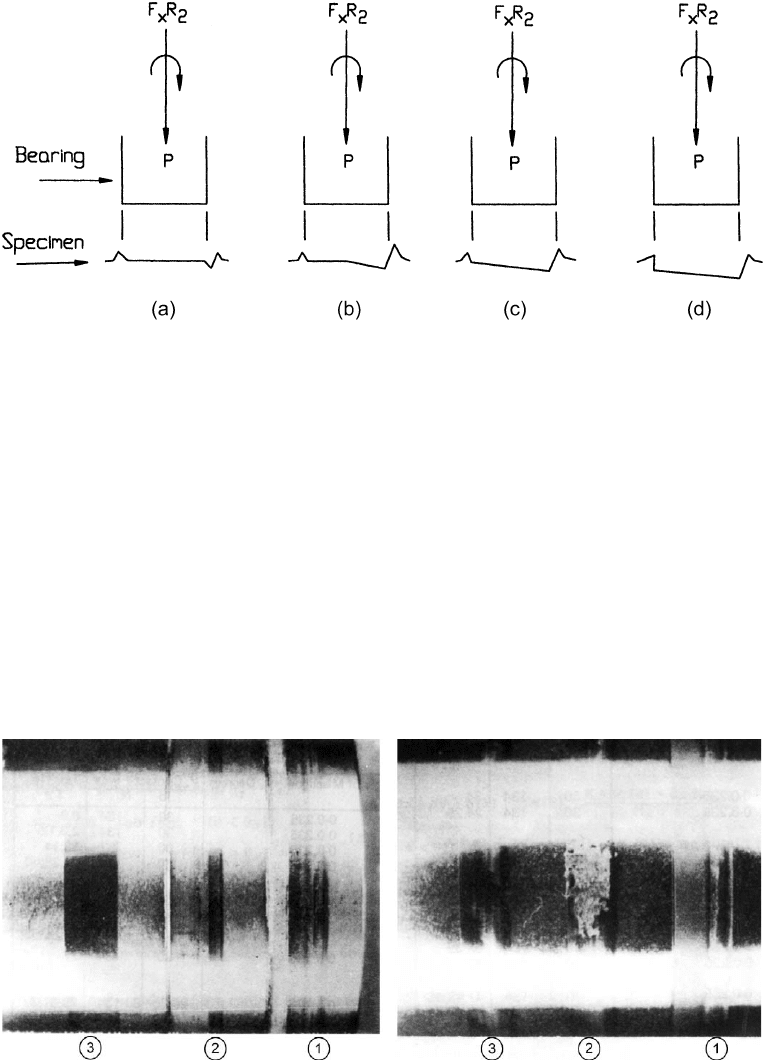
In addition to the measurements and characterization of the wear scars, wear deb ris
was collected and characterized in terms of size, morphology, and composition. These
observations were then integrated into an overall wear assessment of the system.
The maximum depth was used since the scar profile is typically tapered because of
the misalignment. As is pointed out in Ref. 82, misalignment produces a moment at the
interface, which results in nonsymm etric loading of the interface. As a result, a nonuni-
form wear scar tends to occur. A typical profile for a misaligned contact situation, along
withaloadingdiagram,isshowninFig.9.80
.
A wide range of wear behavior was observed in this test. Depending on the amount
of misalignment, loads, and materials involved mild or severe wear resulted. Wear scars,
which have a fretting corrosion morphology, were obtained, as were ones with a morpho-
logysimilartogrosssliding.Figure9.81
shows some of the conditions observed in the test.
Figure 9.80 Illustration of the effects of misalignment on the loading between the roller bearing
and the center specimen and the profile of the wear scars on the center specimen. (From Ref. 127.)
Figure 9.81 Examples of the wear scars occurring on plated center specimen in the rolling test with
misalignment. The amount of misalignment in the test increases from left to right, 0
, 0.117
, and
0.235
. Flaking of the plating is evident in the center scar of ‘‘B’’. (From Ref. 127, reprinted with
permission from ASME.)
Copyright 2004 by Marcel Dekker, Inc. All Rights Reserved.
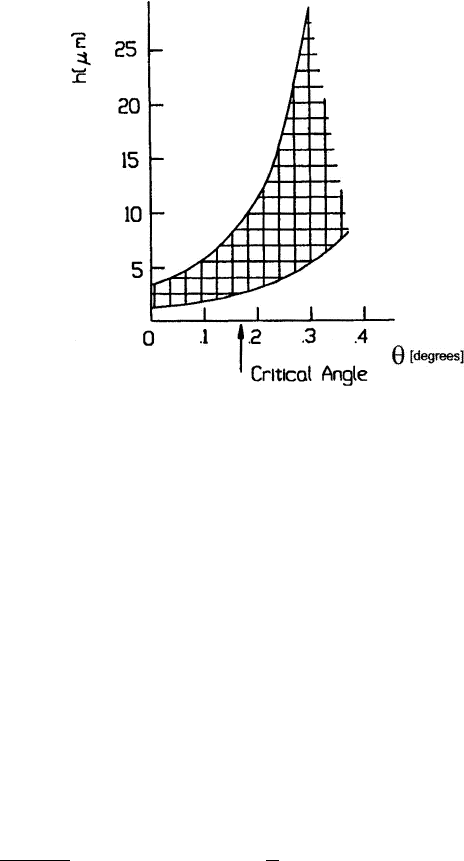
Similar wear behavior, including the occurrence of tapered wear scars, was found in motor
tests, providing verification of the simulative aspects of the test. Of the many parameters
investigated with this test, alignment was the overriding factor. Misalignment was found
to affect both the magnitude and nature of the wear. The magnitude of wear increased
with increasing amounts of misalignment. Transitions not only in the type of wear but
from mild to severe wear were also found to be a function of misalignment. The experi-
mental data indicated a critical angle for misalignment, above which a rapid increa se
inwearratewasobserved(Fig.9.82
).
In addition to the experimental aspects of the study, a theoretical model for such
behavior was developed and used to explain the general trends observed (82). In this
model, a critical angle is identified. Misalignment above this value results in slip over
the entire contact region. Below this value, the compliance of the surfaces is sufficient
tolimitthesliptoregionswithinthecontactzone.Thefollowingequationforthiscritical
angle identifies the parameters involved:
y
c
¼
3:625mP
wbE
c
1
ðvÞþc
2
ðvÞ
10
log
w
b
hi
ð9:23Þ
where m is the coefficient of friction; P is the normal load; w is the length of the contact; b
is the width of the contact; E is the reduced modulus; n is Poisson’s ratio. Values for c
1
andc
2
aregiveninTable9.5.ThisrelationshipisillustratedgraphicallyinFig.9.83.
This test was used to investigate a number of design parameters and aspects as well
as the evaluation of materials and lubricants. The test was used to determine the allowed
rangeofmisalignmentforthedesign,thesizeoftherollers,whetherornotcrownedrollers
shouldbeused,andtoevaluatetheeffectofedgeconditions.Sincethetestingwasdone
with speeds and loads appropriate to the application, selections made on the basis of this
test were directly applicable to the application and consistent with its load capacity and life
requirements. The high degree of simulation allowed the estimation of wear life by the
extrapolation of the data.
Figure 9.82 The general relationship between wear depth and misalignment observed in the rolling
tests. (From Ref. 127, reprinted with permission from ASME.)
Copyright 2004 by Marcel Dekker, Inc. All Rights Reserved.
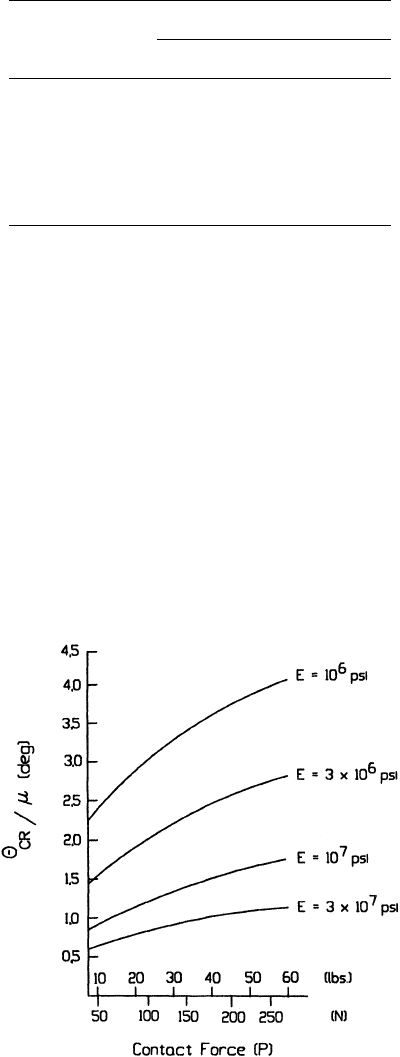
A phenomenological rolling wear test, which could be conducted with slip (Sec.
3.2.10), could pro bably have been used to rank materials in terms of their wear resistance
under combined conditions of rolling and sliding. However, that test canno t provide all
the information that the operational test did. The various effects of misalignment that
were found to occur in the application and significant in terms of life cannot be studi ed
in the phenomenological test (e.g., critical angle and loading alterations), since these
depended on the unique conditions of this application. The slip in the rolling wear test
is the result of different rotational speeds for the rollers, not from misalignmen t. In the
test performed the effect on wear results from the combined influence of misalignment,
loading, and material properties. As a consequence, the phenomenological test only pro-
vides rankings and cannot be used directly in addressing load capacity and life require-
ments. This illustrates a typical difference between these two types of tests.
Table 9.5 Values for C
1
and C
2
of Eq. (9.23) for
the Critical Slip Angle
Poisson’s ratio
vC
1
C
2
0 0.1177 0.2022
0.1 0.1198 0.2224
0.2 0.1202 0.2426
0.3 0.1188 0.2628
0.4 0.1156 0.2831
0.5 0.1107 0.3033
Source: Ref. 126.
Figure 9.83 The relationship between critical angle of misalignment, friction, modulus, and load in
rolling. (From Ref. 127.)
Copyright 2004 by Marcel Dekker, Inc. All Rights Reserved.
9.3.5. Bearing Tests
The wear life of a bearing can be influenced by a variety of factors, which are difficult to
address in phenomenological tests. Also, there can be several wear points and aspects of
the wear that potentially determine life and that are influenced by different factors and
interactions. For example, in the case of roller or ba ll bearings the mixture of rolling
and sliding that takes place at various locations in the bearing is a determining factor
in the life. In these types of bearings, there are two general wear situations which poten-
tially determine life. One is the contact between the cage and the balls or rollers; another is
the contact between the balls or rollers and the races. Which one determines life and the
life itself is significantly affected by the general loading conditions (e.g., mixture of axial
and radial loads, nature of time varying loads), type of motion (e.g., oscillatory or rota-
tional), and preload. Other factors are also involve such as geometrical tolerances, lubrica-
tion, and thermal expan sion. Frequently, these elements interact in a complex way to
determine the nature and the location of the contacts among the various elements of
the bearing (83–86). With journal bearings, the clearance between shaft and bearing
can be a factor in wear behavior, as well as alignment, type of loading, and motion (e.g.,
frequent or rare stop=starts). In journal bearings, these elements can directly influence the
wear in terms of contact pressure or location of the contact and indirectly influence wear
by their influence on the type of lubrication which occurs (e.g., boundary or elastohydro-
dynamic(EHD)).
Again, the effects of these parameters can be co nvoluted and interactive.
Consider the situation with respect to clearance; temperature effects clearance and
clearance influences heat dissipation and therefore tempe rature. Clearance, per se, also
can effect load and pressure distributions and the formation of tribofilms. These factors
in turn can influence friction, which influences temperature, etc. (87–89 ). These complex
interactions and their influence on the nature and location of the wear are difficul t to
simulate in phenomenological tests. As a result, bearing wear tests are used to investigate
these complex aspects, determine design information, and verify performance.
A wide variety of bearing testers, differing in complexity, instrumentation, and size
havebeenusedforthispurpose.SeveraloftheseareillustratedinFigs.9.84
and9.85. The
basic element of these testers is a bearing configuration representative of an application or
typeofapplication.Figure9.86
shows this generic representation. Many of the bearing
tests contain instrumentation to measure both friction and temperature. A variety of wear
measures are used in these tests, depending on a large degree on the nature of the bearing
and the failure criteria. For journal bearings common ones are various forms of measuring
increases in clearance between shaft and bearing (e.g., such as end-play, elongation of
hole, etc.), dimensional and roughness changes on shaft and bearings, and volumetric
and mass changes; the last of these provides a more fundamental characterization. Some-
times increases in friction level and operating temperatures have been used as failure cri-
teria in these types of evaluations. With ball and roller bearings, the measures tend to be
indirect. Frequently, vibration characteristics are used to monitor bearing performance,
since vibrations tend to increase as wear takes place. Also, play or slop in the bearing
can be used as a measure. More basic wear measurements on the various components
of the bearing can be used as well (e.g., depth of wear scar on race, mass loss of cage).
However, in many cases, the useful life of the bearing is associated with very smal l geome-
trical changes on these components. For example, when increased vibration level s asso-
ciated with the end of life are detected, the wear on the rollers and races may only
manifestthemselvesasincreasesinroughness,suchasshowninFig.9.87
. Increases in
temperature and friction in these bearings are also used as measures of life in some cases.
Copyright 2004 by Marcel Dekker, Inc. All Rights Reserved.
